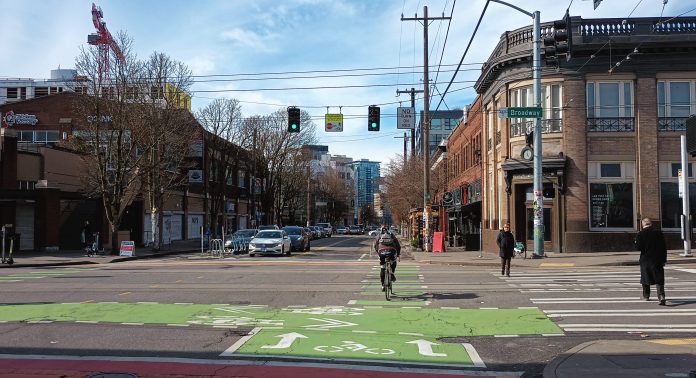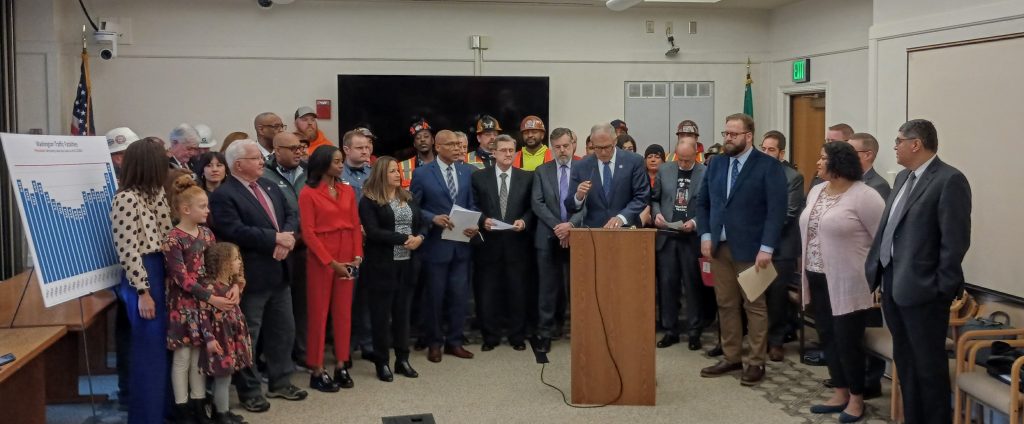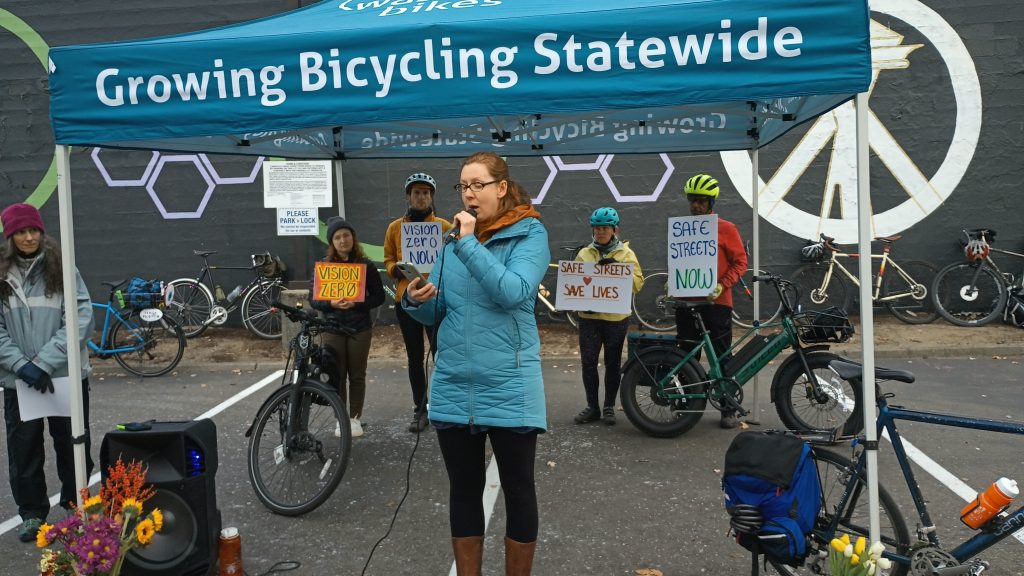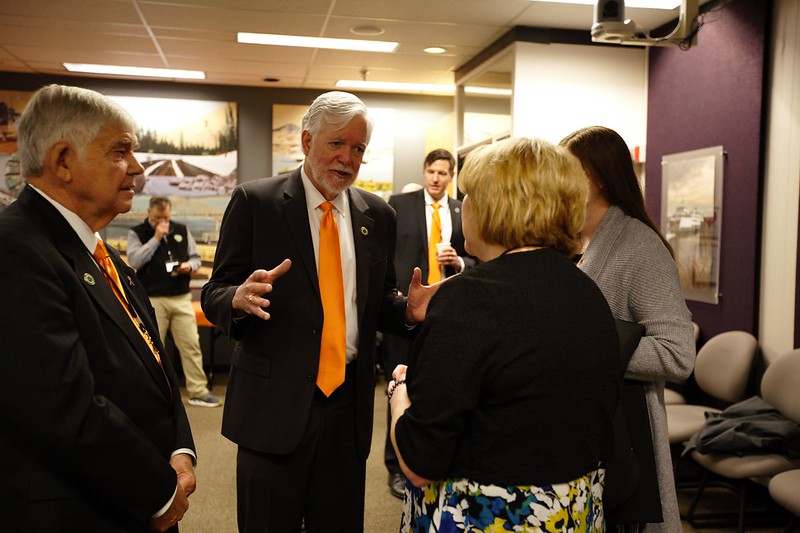
In late January, a group of lawmakers from both the Washington House and Senate, Democrats and Republicans, joined Governor Jay Inslee in a legislative conference room to announce that reducing traffic deaths on the state’s roadways would be a major priority for the 105-day legislative session. Looming over the group was a large poster, depicting the number of lives lost in Washington by year: the chart spiked in 2022, with an estimated 745 fatalities.
“It’s a painful thing to know that 745 people did not get home safely last year, and that those numbers have increased the last couple of years,” Governor Inslee said that day. “The good news is, we have a team assembled behind me, and I believe in the state legislature, this year they will take significant steps to reduce this carnage on our highways.” A laundry list of bills intended to reverse the alarming trend were discussed, touching on everything from driving under the influence, driver training, and (some) systemic infrastructure changes.

But that number of 745 was not final, with records still being reviewed even through today. Just last week, the Washington Traffic Safety Commission held its quarterly meeting, and the update was even more sobering. Staci Hoff, the commission’s research director, confirmed that the number was at 751 as of that meeting…and still climbing. The tally increases as people who were involved in crashes but passed away after-the-fact in hospitals were added to the official count.
“I believe our final 2022 number will land anywhere between 760 to 770 when we finish our operations,” Hoff said. In 2022, 670 people had been killed by traffic violence, which then had been a high number not seen since the 1990s. Yet 2022 was projected to be higher by around 100.
Hoff’s bad news did not stop there. “2023 is very much looking like the first half of 2022, which was historically bad in those early months of the year,” she said. “I anticipate at this time that the first quarter of 2023 will also end up being higher than 2022.”
If anything, the issue has become more urgent since January. But now that the legislature has wrapped up its session, we see the result: many of the bills touted at the January press conference were either left behind or watered down, with other pressing issues like housing, firearms access, and education dominating much of the Legislature’s floor and committee time.
Bills That Made It
Among the changes that the legislature was able to pass this year, one likely to be the most impactful is new authorization for the Washington State Department of Transportation (WSDOT) to install automatic speed cameras in highway work zones. Over the past 10 years, WSDOT work zones have seen over 600 injuries per year, with six people, either state employees or members of the travelling public, killed in 2022 after being hit by another driver in a work zone. Traffic fines are already doubled when a motorist commits an infraction inside a work zone, but a lack of enforcement has led to injuries continuing to increase.
Another priority was driver’s education for younger people. Currently, people seeking a driver’s license when they’re under 18 are required to complete a driver’s ed course. That requirement disappears the day someone turns 18, creating a perverse disincentive to wait, impacting that driver’s likelihood to be involved in a crash. Data shows that completing a driver’s education course leads to a substantially decreased chance of being involved in a crash, and that this effect lasts long into that driver’s life. SB 5583 would have expanded driver’s ed to everyone under 24 years old who is getting their license for the first time, and provided financial assistance for low income drivers to be able to take driver’s ed.
The bill made it across the finish line, but not without being completely overhauled in the House into a bill that doesn’t require much. Washington’s Department of Licensing is now directed to create a “comprehensive implementation plan” to expand driver’s ed for those new age groups, with a deadline of getting a report to the legislature by the end of next year. That new plan will still need to be approved by the legislature, starting the process all over. Any impacts from this bill, if even realized, won’t be seen until the second half of the decade.
Bills That Fell Flat
The centerpiece bill this year on traffic safety was supposed to be SB 5002, which would have made Washington the second state in the country to adopt a 0.05% blood-alcohol content standard, following Utah’s lead. The low level is ubiquitous in Europe, but nearly every state in the US has a 0.08% threshold. Utah saw a big drop in traffic fatalities in 2019 following implementation of the law, and traffic safety experts predicted the change would save dozens of lives in Washington every year. The National Transportation Safety Board has been calling on every state to adopt the lower standard since 2013, with the results in Utah causing the federal agency to double down on its push.
But the law faced opposition from alcohol industry groups, including the Washington Brewers Guild, the Washington Hospitality Association, and the Washington Wine Institute, who raised concerns about increased liability for alcohol providers. The bill was advanced through the Senate, even getting as far as the Senate’s floor calendar on the final day that the bill could have passed. In fact the bill was next in queue when the body turned its attention to a bill loosening the standards for police officers to engage in pursuits, a move many traffic safety advocates are wary of.
The legislature did decide to advance a number of bills liberalizing the state’s alcohol laws, including a law that allows Airbnb hosts to provide guests with a free bottle of wine without violating state law and another that extends the ability of restaurants to deliver beer and wine. Senator Marko Liias (D-21, Edmonds), the sponsor of SB 5002, opposed that latter change, specifically citing the negative trend on traffic safety.

Another highly anticipated bill this year was HB 1582, and its counterpart, SB 5514, which would have required Washington cities to restrict free right-turn-on-red within 1000 feet of a school, park, library, hospital, or other high pedestrian-traffic facility, with direct signage required at every intersection.
“This simple change would make intersections safer for children, seniors, and other pedestrians at a time when traffic violence is at a three-decade high,” John Lovick (D-44, Lake Stevens), sponsor of the Senate version, noted at the only public hearing the bill received in that chamber. Neither it nor the House version was advanced to any vote. The idea of eliminating free-right-on-red was a new idea for the legislature, and will likely return in a future year, but it was pretty clear that the appetite to make this change was very limited, despite the purported urgency around safety.
HB 1674, introduced relatively late in the session, would have been an attempt to make an impact on the increasing impact (so to speak) from larger trucks and SUVs dominating US roadways. The bill would have required light trucks and mid- and large-sized SUVs to come with a warning label: “Due to its size and weight, this vehicle likely poses increased risk to other roadway users,” the label would have read, and would go on to note that, due to HB 1674, an additional $100 fine may be added to traffic infractions committed in such a vehicle such as failure to stop at an intersection or going over 10 mph over the posted speed limit.
Ultimately, influencing vehicle design will only be effective at the Federal level, but HB 1674 was a first attempt to make a difference when it comes to the ubiquitous large vehicles’ negative safety outcomes for users outside of vehicles. This bill too only received one public hearing and didn’t advance even to a committee vote.
The Inconvenient Truth
By the time legislative deadlines had made clear that 2023 would not be a banner year for traffic safety, WSDOT Secretary Roger Millar stepped to the podium to address a national gathering of highway safety professionals at the annual Lifesavers conference, held in Seattle in early April. Millar offered a forthright view of the reason many of the bills had not been able to advance.
“Inconvenience is our enemy,” Millar said. “That is the thing that stops us every time. We were making some progress on that BAC going from .08 to .05 but inconvenience was a problem. We were talking about eliminating right turn on red in a lot of situations, but inconvenience stopped us. I battle that inconvenience bugaboo all the time.”

Millar noted there was much that his own agency had to do to improve on traffic safety, bringing up as a bright spot the state’s 2022 complete streets mandate requiring the agency to assess how to fill gaps in bike and pedestrian networks every time maintenance work is advanced. But he called on the National Highway Traffic Safety Administration to move forward on things like speed limiters for passenger vehicles, an initiative moving forward in Europe. And he noted that the state would likely not make progress toward its traffic safety goals if the tough issues weren’t tackled.
“We are a Target Zero state, that’s nice, but inconvenience keeps getting in the way,” he said. Earlier this year, the Traffic Safety Commission held a roundtable discussion on whether the state’s Target Zero goal of eliminating traffic fatalities and serious injuries by 2030 should be changed, with a strong consensus in that group that the goal should not be abandoned.
The dynamics of traffic violence are not likely to change, even if the state doubles down on what it’s relied upon in the past: increasing education and enforcement activities. The legislature this year demonstrated that the alternate path, which actually may inconvenience some people, will be a much harder road. But more stringent limits on the operation of vehicles are likely the only changes that will make a difference.
Ryan Packer lives in the Summit Slope neighborhood of Capitol Hill and has been writing for the The Urbanist since 2015. They report on multimodal transportation issues, #VisionZero, preservation, and local politics. They believe in using Seattle's history to help attain the vibrant, diverse city that we all wish to inhabit. Ryan's writing has appeared in Capitol Hill Seattle Blog, Bike Portland, and Seattle Bike Blog, where they also did a four-month stint as temporary editor.


